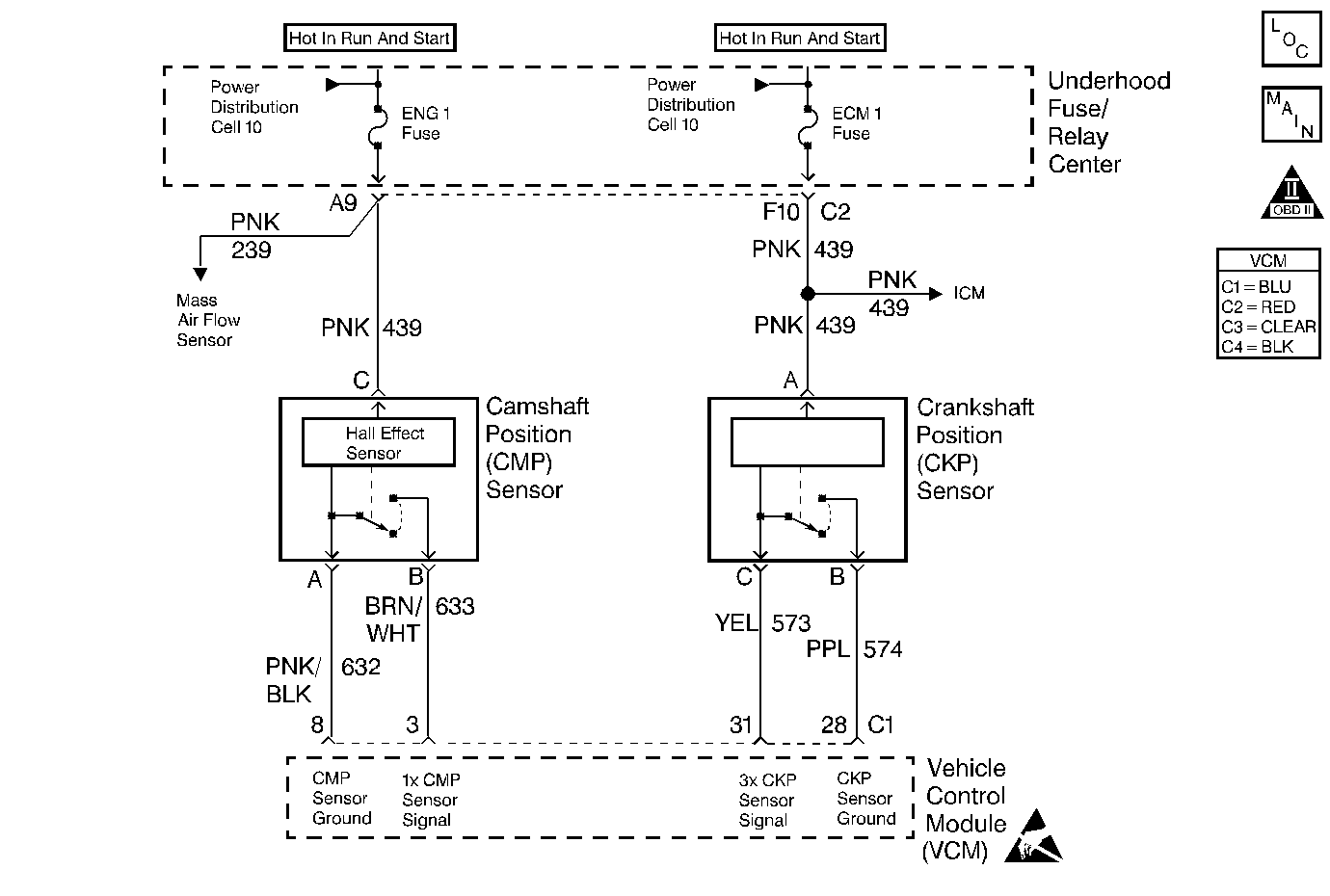
Circuit Description
This diagnostic trouble code (DTC) monitors the crankshaft position (CKP) and the camshaft position (CMP) signals to determine if they are synchronized. If both signals are not observed by the control module within a narrow time window, the vehicle control module (VCM) will determine that an error has occurred.
Conditions for Running the DTC
The engine is running.
Conditions for Setting the DTC
The falling edge of the CMP sensor signal leads or lags the falling edge of the CKP sensor by more than 26 degrees.
Action Taken When the DTC Sets
| • | The control module illuminates the malfunction indicator lamp (MIL) the first time the diagnostic runs and fails. |
| • | The control module will set the DTC and records the operating conditions at the time the diagnostic fails. The control module stores the failure information in the scan tools Freeze Frame/Failure Records. |
Conditions for Clearing the MIL or DTC
| • | The control module turns OFF the MIL after 3 consecutive drive trips when the test has run and passed. |
| • | A history DTC will clear if no fault conditions have been detected for 40 warm-up cycles. A warm-up cycle occurs when the coolant temperature has risen 22°C (40°F) from the startup coolant temperature and the engine coolant reaches a temperature that is more than 70°C (158°F) during the same ignition cycle. |
| • | Use a scan tool in order to clear the DTCs. |
Diagnostic Aids
Check for the following items:
| • | A loose CMP sensor causing a variance in the sensor signal |
| • | Excessive free play in the timing chain and gear assembly |
| • | Incorrectly installed distributor--1 tooth off in either the advance or the retard positions |
| • | A loose distributor rotor on the distributor shaft |
| • | A loose or missing distributor hold down bolt |
An intermittent may be caused by any of the following conditions:
| • | A poor connection |
| • | Rubbed through wire insulation |
| • | A broken wire inside the insulation |
Thoroughly inspect any circuitry that is suspected of causing the intermittent complaint. Refer to Intermittent Conditions in Wiring Systems.
If a repair is necessary, refer to Wiring Repairs .
Test Description
The numbers below refer to the step numbers on the table.
-
This test will determine if this DTC is intermittent.
-
If there is a variance in the camshaft sensor signal it will be detected in this step.
-
Unintentional damage to the distributor shaft may result if excessive pressure is used to rotate the distributor.
Step | Action | Value(s) | Yes | No |
|---|---|---|---|---|
1 |
Important: Before clearing the DTCs, use the scan tool Capture Info to save the Freeze Frame and Failure Records for reference. The control module's data is deleted once the Clear Info function is used. Did you perform the Powertrain On-Board Diagnostic (OBD) System Check? | -- | ||
2 |
Does the engine speed fluctuate (up to twice the desired RPM)? | -- | ||
3 | Replace the crankshaft position sensor. Refer to Crankshaft Position Sensor Replacement . Is the action complete? | -- | -- | |
Perform the Camshaft Retard Offset test procedure as follows:
Important: The camshaft retard reading is not accurate below 1000 RPM. Is the camshaft retard reading within the second specified value? | 1000 RPM -5° to -17° | |||
Does the camshaft retard reading change more than the second specified value? | 2000 RPM 2° | Go to Diagnostic Aids | ||
With the engine at operating temperature and the engine OFF perform the following procedure:
Does the rotor turn on the distributor shaft? | -- | |||
7 |
Did you find a problem? | -- | Go to Diagnostic Aids | |
8 | Replace the distributor. Refer to Distributor Replacement in Engine Electrical. Is the action complete? | -- | -- | |
9 |
Does the scan tool indicate the diagnostic Passed? | -- | ||
10 | Does the scan tool display any additional undiagnosed DTCs? | -- | Go to the applicable DTC table | System OK |
